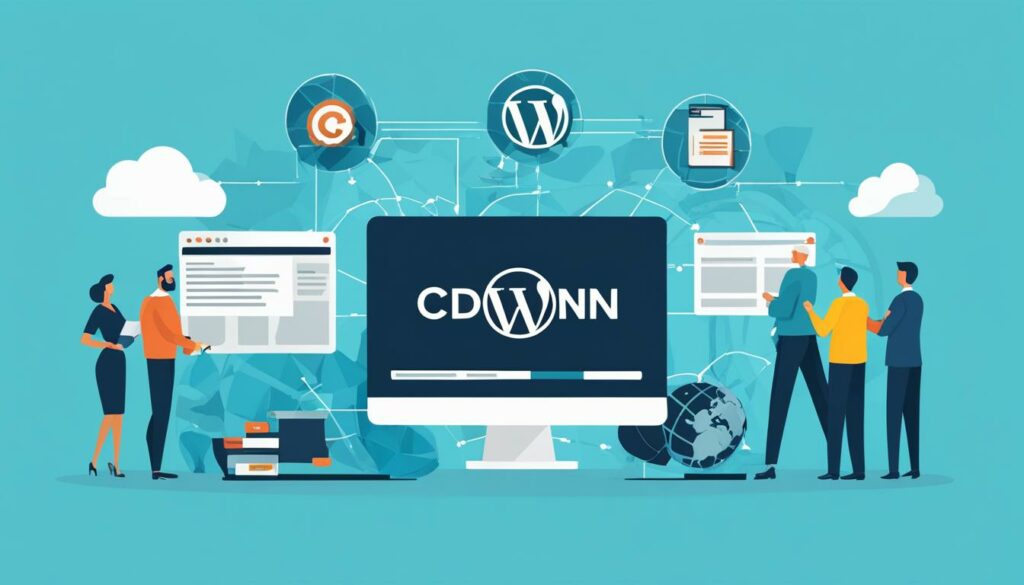Looking to boost the performance of your WordPress website? Integrate a Content Delivery Network (CDN) and take your site speed to the next level. By implementing a WordPress CDN, you can optimize load times and enhance the user experience for your website visitors. However, before diving into the integration process, it’s essential to understand the challenges and strategies involved.
Key Takeaways:
- A WordPress CDN can significantly improve the performance and speed of your website.
- Evaluating your site’s performance before integration is crucial for identifying areas that need improvement.
- Choosing the right CDN provider with the necessary features for your WordPress site is essential.
- Preparing your WordPress site involves optimizing images, files, and configuring server settings.
- Integrating the CDN with your WordPress site requires selecting a pricing plan, configuring the plugin, and testing the integration.
In this article, we’ll walk you through the process of leveraging a WordPress CDN, from evaluating your website’s performance to integrating the CDN and optimizing your setup. We’ll cover everything you need to know, including how to choose the right CDN provider, prepare your site, and ensure smooth integration.
So, whether you’re looking to improve load times, enhance user experience, or cater to a global audience, keep reading to discover the challenges and strategies of using a WordPress CDN to optimize your website.
Evaluating WordPress Performance Before CDN Integration
Before integrating a CDN (Content Delivery Network) into your WordPress site, it is crucial to evaluate its performance. By conducting a comprehensive performance audit, you can analyze key metrics such as load times, server response times, and page size. This evaluation will help you identify potential areas for improvement and optimize your site’s performance.
There are several tools available to benchmark your WordPress site’s performance. Two popular options are GTmetrix and Pingdom. These tools provide detailed reports on various performance indicators, giving you valuable insights into your site’s strengths and weaknesses. Use these reports to track your progress and set performance goals.
Key Metrics to Evaluate
When evaluating your WordPress site’s performance, pay attention to the following key metrics:
- Load Times: Measure the time it takes for your website to load fully. Faster load times lead to improved user experience and better search engine rankings.
- Server Response Times: Evaluate how quickly your server responds to incoming requests. Lower response times contribute to faster page loading.
- Page Size: Analyze the size of your webpages, including all the files and content they contain. Smaller page sizes generally result in faster load times.
Additionally, considering the impact of user geography on your site’s performance is essential. Users located farther away from your server may experience longer load times due to increased latency. This consideration is especially crucial if you have a global audience.
Identifying Potential Bottlenecks
During your performance evaluation, focus on identifying potential bottlenecks that may be affecting your site’s speed and performance. Common bottlenecks include:
- Unoptimized images and media files
- Large CSS and JavaScript files
- Inefficient server configurations
- Heavy database queries
By pinpointing these bottlenecks, you can develop a targeted plan for optimization and ensure a smooth integration with your chosen CDN.
Assessing Static Content for CDN Caching
Static content on your WordPress site, such as images, CSS, and JavaScript files, can benefit from CDN caching. This caching allows the CDN to serve this content directly from the edge servers, reducing the load on your origin server and improving delivery times for static resources.
| Metric | Description |
|---|---|
| Load Times | The time it takes for your website to load fully |
| Server Response Times | The time it takes for your server to respond to incoming requests |
| Page Size | The size of your webpages, including all the files and content they contain |
Assess the type and size of your site’s static content to determine which elements should be cached by the CDN. This analysis will help you optimize your CDN integration and ensure that the most critical elements of your site benefit from the CDN’s performance-enhancing capabilities.
Selecting the Right CDN for Your WordPress Site
When it comes to integrating a Content Delivery Network (CDN) into your WordPress site, selecting the right CDN provider is crucial for optimizing performance and user experience. Several factors should be considered during your selection process to ensure the chosen CDN aligns with your site’s specific needs.
- CDN Provider: Evaluate different CDN providers and their offerings to find one that suits your requirements.
- Network Size: Consider the CDN’s network size, as a larger network typically ensures better coverage and faster content delivery to users worldwide.
- POP Locations: Check the Point of Presence (POP) locations of the CDN provider to ensure they have servers close to your target audience’s geographical locations.
- Pricing Models: Review the pricing models of different CDN providers to find a plan that aligns with your budget and expected traffic.
- SSL/TLS Support: Ensure that the CDN provider offers SSL/TLS support to secure data transmission between your site and users.
- HTTP/2 and HTTP/3 Support: Look for CDN providers that support the latest HTTP protocols, such as HTTP/2 and HTTP/3, to enable faster content delivery.
- DDoS Protection: Choose a CDN provider that offers robust DDoS protection to safeguard your WordPress site against malicious attacks.
- Cache Control Options: Assess the cache control options provided by the CDN provider to optimize caching and content delivery for your site.
- Compatibility with Hosting Provider: Ensure the CDN provider is compatible with your hosting provider, allowing for seamless integration.
- WordPress-Specific Features: Look for CDN providers that offer WordPress-specific features or plugins, simplifying the integration process and providing additional benefits tailored to WordPress sites.
By carefully selecting a CDN provider that meets these criteria, you can enhance your WordPress site’s performance, improve loading times, and provide a seamless experience to your visitors.
WordPress CDN Comparison
| CDN Provider | Network Size | POP Locations | Pricing Models | SSL/TLS Support | HTTP/2 and HTTP/3 Support | DDoS Protection | Cache Control Options | Compatibility with Hosting Providers | WordPress-Specific Features |
|---|---|---|---|---|---|---|---|---|---|
| CDN Provider A | Extensive network with global coverage | Multiple POPs worldwide | Flexible pricing plans suitable for various traffic levels | Full SSL/TLS support | Supports HTTP/2 and HTTP/3 protocols | Robust DDoS protection | Advanced cache control options | Compatible with major hosting providers | WordPress-specific caching plugins available |
| CDN Provider B | Large network with regional coverage | POP locations in key regions | Simple pricing tiers based on bandwidth | Partial SSL/TLS support | Supports HTTP/2 protocol | Basic DDoS protection | Basic cache control options | Compatible with select hosting providers | Basic WordPress caching functionality |
Consider the comparison above when making your decision. Remember to prioritize the features and capabilities that align with your WordPress site’s specific needs for optimal performance and seamless integration.
With the right CDN provider chosen, you can now move on to the next step: preparing your WordPress site for CDN integration.
Preparing Your WordPress Site for CDN Integration
Before integrating a CDN with your WordPress site, it’s important to ensure that your site is properly prepared. Taking the necessary steps beforehand can help optimize your site’s performance and maximize the benefits of CDN integration.
Here are some key tasks to complete:
1. Backup Your Data
Start by creating a backup of your WordPress site, including all its files and databases. This ensures that you have a copy of your site in case anything goes wrong during the integration process.
2. Update WordPress, Themes, and Plugins
Ensure that you are running the latest version of WordPress, along with any themes and plugins installed on your site. Regular updates help address security vulnerabilities and improve compatibility with the CDN integration.
3. Optimize Images and Static Files
Optimizing your images and static files can greatly improve your site’s performance. Use image compression techniques to reduce file sizes without compromising quality. Additionally, minify CSS and JavaScript files to reduce their size and load time.
4. Clean Up Your WordPress Database
Over time, your WordPress database can accumulate unnecessary data that slows down your site. Use a plugin or perform a manual cleanup to remove unused data, such as spam comments, post revisions, and transient options.
5. Configure Your Server
Ensure that your server is properly configured for CDN integration. Update your DNS settings to point to the CDN provider’s servers. Enable Cross-Origin Resource Sharing (CORS) to allow your site to fetch resources from the CDN. Set cache control headers to optimize caching and ensure efficient content delivery.
By completing these preparatory tasks, you’ll be ready to seamlessly integrate a CDN with your WordPress site, enhancing its performance and user experience.
Remember, when it comes to CDN integration, preparation is key. Taking the time to back up your data, update your site, optimize files, clean up your database, and configure your server will set the stage for a successful integration and improved website performance.
Integrating CDN with Your WordPress Site
Now that you have selected the perfect CDN provider for your WordPress site, it’s time to integrate it seamlessly. This section will guide you through the process of CDN registration, choosing a pricing plan, configuring CDN settings, and installing a CDN plugin on your WordPress site.
CDN Registration and Pricing Plan
Start by registering with your chosen CDN provider. Visit their website and create an account by providing the required details. Once registered, you can explore the pricing plans offered by the CDN provider. Evaluate the available options based on your website’s needs and budget. Select a plan that best suits your requirements and proceed to the next step.
CDN Configuration
After selecting a pricing plan, it’s time to configure your CDN settings. The configuration process may vary depending on the CDN provider you have chosen. Refer to the documentation or support resources provided by your CDN provider for detailed instructions on how to configure the CDN settings for your WordPress site. Pay attention to key settings such as caching rules, SSL/TLS support, and cache control options to optimize the delivery of your website’s content.
CDN Plugin Installation and Configuration
Next, you’ll need to install and configure a CDN plugin on your WordPress site. Popular CDN plugins for WordPress include W3 Total Cache and WP Super Cache. These plugins simplify the integration process and ensure smooth communication between your website and the CDN. Choose a plugin that is compatible with your CDN provider and follow the installation instructions provided by the plugin developer. Once installed, configure the plugin settings to connect your WordPress site with the CDN.
Testing CDN Integration
After completing the CDN integration process, it’s crucial to test whether your website’s content is being delivered through the CDN. Tools like CDN Finder or Pingdom can help you verify if your content is being served from the CDN’s edge servers. These tests ensure that your CDN integration is successful and content delivery is optimized.
Performance Monitoring and Troubleshooting
Once your CDN is integrated, it’s important to monitor your site’s performance. Keep a close eye on metrics like page load times, server response times, and overall user experience. Leverage performance monitoring tools and CDNs’ own analytics dashboards to gather valuable insights and identify any issues that may arise. If you encounter any performance issues, refer to your CDN provider’s support resources or reach out to their support team for troubleshooting assistance.

Integrating a CDN with your WordPress site using the steps outlined above will help you optimize performance, improve user experience, and ensure fast content delivery to your global audience. Take advantage of the CDN’s speed and reliability by registering, configuring, and installing the necessary plugins. Remember to test the integration and monitor performance regularly to troubleshoot any issues that may impact your site’s speed and performance.
Optimizing Your WordPress Site Post-CDN Integration
Now that you have successfully integrated a CDN with your WordPress site, it’s time to optimize your setup for peak performance. By fine-tuning CDN settings, leveraging advanced features, and optimizing your site’s content, you can further enhance speed, improve SEO, and ensure scalability for future growth.
1. Adjust CDN Settings
Customize CDN settings to maximize performance. Fine-tune Time to Live (TTL) values to determine how long content will remain in the CDN cache. Configure custom caching rules to control how specific files or types of content are cached. These settings allow for more efficient content delivery and improve overall user experience.
2. Leverage Advanced Features
Take advantage of advanced features like HTTP/3 and QUIC to optimize your site’s speed and performance further. HTTP/3 is the latest version of the HTTP protocol, designed to improve communication efficiency between servers and clients. QUIC (Quick UDP Internet Connections) is a protocol that enhances security and speed by reducing latency and connection establishment times.
3. Optimize Images, CSS, and JS Files
Use image optimization techniques to reduce file sizes without compromising image quality. Compress images and serve them in formats like WebP to minimize load times. Utilize plugins for CSS/JS minification to remove unnecessary code and reduce file sizes, improving overall page performance.
4. Clean Up Your Database
Perform regular database cleanup to remove unnecessary data and optimize its performance. Eliminate unused plugins, themes, and database entries to reduce database load and improve site speed. Consider using plugins specifically designed for database cleanup to streamline the process.
5. Utilize CDN Analytics
Take advantage of the analytics provided by your CDN to gain valuable insights into your site’s performance. Monitor metrics such as bandwidth usage, caching efficiency, and user geographical distribution. Use this data to inform your optimization strategies and make data-driven decisions to improve the overall performance of your WordPress site.
6. Implement a CDN-Friendly SEO Strategy
Optimize your site’s content and structure to ensure it is easily crawlable by search engines while taking full advantage of the CDN’s caching capabilities. Comply with best practices for SEO, such as optimizing metadata, using descriptive alt tags for images, and creating SEO-friendly URLs. A CDN-friendly SEO strategy will help boost your site’s visibility in search engine rankings and improve organic traffic.
7. Plan for Scalability
As your site continues to grow and attract more traffic, plan for scalability to ensure uninterrupted performance. Opt for a CDN that offers flexible pricing plans and can accommodate increased traffic without compromising speed or user experience. Regularly reassess your CDN setup to ensure it aligns with your site’s evolving needs.
By following these optimization techniques and strategies, you can fully capitalize on the power of a CDN integration for your WordPress site, providing visitors with a seamless browsing experience, improved load times, and scalability for future growth.
What is a CDN?
A Content Delivery Network (CDN) is a network of geographically distributed proxy servers that work together to speed up content delivery to end users. CDN servers are strategically located at high-speed internet fiber cable junction points to reduce latency and minimize the distance content needs to travel to reach users. CDNs cache and serve static resources, such as media, fonts, CSS, and JS files, from servers closer to users, resulting in faster load times.
CDNs are designed to optimize the delivery of static resources on websites, leveraging their geographically distributed PoPs (Points of Presence) to serve cached content efficiently. By storing copies of static resources on CDN servers around the world, CDNs can minimize the distance between users and the server serving the content. As a result, users experience reduced latency and faster load times, particularly when accessing websites or applications from distant locations.
When a user visits a website using a CDN, their browser automatically retrieves the static resources, such as media, fonts, CSS, and JS files, from the CDN server closest to their physical location. This process drastically reduces the time it takes for the content to reach the user’s browser, resulting in a better user experience.
CDNs offer several advantages for website owners. By serving static resources from CDN servers, website owners can offload the traffic from their origin server, reducing the load on their infrastructure and minimizing the risk of server overload during traffic spikes. CDNs also provide an additional layer of security by acting as a shield against DDoS (Distributed Denial-of-Service) attacks, mitigating the impact of malicious traffic on the website or application.

How WordPress CDN Works
When it comes to optimizing your WordPress site for faster load times and improved performance, integrating a Content Delivery Network (CDN) is a game-changer. But how does a WordPress CDN actually work? Let’s dive in and explore the intricacies of this powerful technology.
A CDN operates using reverse proxy load balancing, which involves distributing traffic across multiple CDN servers. This ensures that the load is evenly spread, preventing any single server from becoming overwhelmed by the influx of requests. By effectively balancing the load, a CDN can handle high volumes of traffic without compromising performance.
One of the key benefits of a WordPress CDN is caching. CDN servers store static resources, such as images, CSS files, and JavaScript libraries, and serve them directly from servers located closer to the end users. By reducing the distance content needs to travel, a CDN significantly improves load times for visitors accessing your website from different regions.
But the benefits of a WordPress CDN don’t stop at caching. CDNs can also optimize and serve entire webpages, not just static resources. This means that dynamic content, such as blog posts or product listings, can be delivered more efficiently, resulting in faster page rendering and a better user experience.
To fully leverage the power of a WordPress CDN, it’s crucial to create CDN-friendly websites. This involves optimizing your website for CDN integration by adhering to best practices such as minifying CSS and JavaScript files, enabling Gzip compression, and optimizing images. By implementing these optimizations, your WordPress site becomes even more efficient and performs better on the CDN.
By utilizing reverse proxy load balancing, distributing traffic, caching static resources, serving content closer to users, and optimizing webpages, a WordPress CDN offers immense benefits in terms of speed, performance, and user experience. Take advantage of this powerful technology and unlock the full potential of your WordPress site.
| Benefits of WordPress CDN | Description |
|---|---|
| Faster Load Times | A WordPress CDN reduces latency and minimizes the distance content needs to travel, resulting in faster load times for your website. |
| Improved Performance | By distributing traffic across multiple CDN servers, a WordPress CDN ensures optimal performance even during high traffic periods. |
| Optimized Webpages | A CDN can optimize and serve entire webpages, making them load faster and improving the user experience. |
| CDN-Friendly Websites | By following CDN best practices, such as minifying files and optimizing images, you can create CDN-friendly websites that leverage the full power of a WordPress CDN. |
Do You Need a CDN for WordPress?
A Content Delivery Network (CDN) is highly recommended for WordPress sites aiming to improve load times and enhance user experience. With CDN caching and the ability to serve content from servers closer to users, CDNs can significantly optimize load times, especially for WordPress sites with a global audience.
One of the key advantages of using a CDN is its ability to improve the delivery speed of media files. By optimizing media files and reducing their size, CDNs ensure faster loading times for images, videos, and other media assets on your WordPress site.
CDNs also play a crucial role in handling traffic spikes. During periods of increased traffic, CDNs efficiently distribute the load across multiple servers, preventing performance bottlenecks and ensuring a seamless user experience.
Another noteworthy benefit of CDNs is their ability to protect websites from distributed denial-of-service (DDoS) attacks. CDNs have built-in security features that actively monitor and mitigate DDoS attacks, keeping your WordPress site safe and accessible even under heavy traffic loads.
“Using a CDN for your WordPress site can vastly improve load times, provide better user experience, and protect your site from traffic spikes and DDoS attacks.”
However, it’s important to note that CDNs are not only for WordPress sites experiencing global traffic and traffic spikes. Even if your site caters to a smaller audience, CDN caching can still improve load times and overall performance, resulting in a better user experience.
In addition, CDNs offer various features that allow you to optimize your WordPress site further. They provide analytics and reporting tools to monitor performance metrics, offering insights into how to further enhance your site. By utilizing CDN-friendly SEO strategies, you can ensure your WordPress site is easily discoverable and accessible to a wider online audience.
In summary, whether you have a global audience, experience traffic spikes, or simply want to improve load times and user experience, integrating a CDN into your WordPress site is highly recommended. CDNs not only optimize load times and handle increased traffic but also provide valuable tools and features to enhance your overall website performance.
Benefits of Using a CDN on Your WordPress Site
Integrating a Content Delivery Network (CDN) into your WordPress site brings numerous benefits that enhance your website’s performance and user experience. Let’s explore the advantages of using a CDN:
- Faster Pages: CDNs reduce page load times by serving content from edge servers located closer to your users, optimizing the delivery process and ensuring faster access to your website.
- Performance Boost: With a CDN, you can significantly improve various performance metrics such as Time to First Byte (TTFB), Largest Contentful Paint (LCP), Time to Interactive (TTI), and First Input Delay (FID). These optimizations result in smoother and more responsive user experiences.
- Low Bandwidth Costs: By caching and serving content from edge servers, CDNs help reduce bandwidth costs associated with delivering large files and handling high traffic volumes.
- Media Optimization: CDNs play a crucial role in optimizing media files, including images, videos, and audio. By caching and compressing these files, CDNs reduce their sizes and enhance their delivery speed, contributing to overall website performance.
- Protection from DDoS Attacks: CDNs provide an additional layer of security by protecting your WordPress site from Distributed Denial-of-Service (DDoS) attacks. The network infrastructure and caching capabilities of CDNs can absorb and mitigate such attacks, ensuring your website stays online and accessible.
- Increased Website Uptime: By caching copies of your website on edge servers, CDNs ensure that your content remains available even during downtime or server outages. This increased uptime leads to better user experiences and prevents potential revenue loss.
In summary, integrating a CDN into your WordPress site offers faster page loading times, a significant performance boost, reduced bandwidth costs, media optimization, protection from DDoS attacks, and increased website uptime. These benefits are essential for providing an exceptional user experience and optimizing your website’s overall performance.
CDN Benefits Comparison
| Benefit | Description |
|---|---|
| Faster Pages | CDNs reduce page load times and optimize content delivery. |
| Performance Boost | CDNs improve TTFB, LCP, TTI, and FID, enhancing user experience. |
| Low Bandwidth Costs | CDNs cache and serve content, reducing bandwidth expenses. |
| Media Optimization | CDNs optimize media files, such as images, videos, and audio. |
| Protection from DDoS Attacks | CDNs provide an additional security layer to guard against DDoS attacks. |
| Increased Website Uptime | CDNs cache copies of your site, ensuring availability during downtime. |
With these benefits in mind, integrating a CDN into your WordPress site can significantly improve performance and provide a seamless user experience for your visitors.

Who Should Use a CDN WordPress Plugin?
If you have a WordPress website with a global audience, optimizing load times for users in different regions is essential. A CDN WordPress plugin can help you achieve just that. Serving your content from edge servers closer to your global users can significantly improve their browsing experience.
If your website has a large media library, optimizing your media assets is crucial for faster page loading. With CDN caching and resizing capabilities, a CDN WordPress plugin can efficiently handle the delivery of your media files, reducing their size and improving load times.
Handling traffic spikes can be challenging, especially if you experience sudden surges in user activity. CDNs help distribute traffic across multiple servers, ensuring improved load times even during peak periods. Additionally, CDNs provide protection against Distributed Denial-of-Service (DDoS) attacks, ensuring the security and availability of your website.
By integrating a CDN WordPress plugin, you can enjoy improved load times, enhanced media optimization, and increased website uptime. Let’s take a deeper look at the benefits and features of using a CDN WordPress plugin in the following table:
| Benefits | Features |
|---|---|
| Improved Load Times | CDN caching and content delivery from edge servers. |
| Media Optimization | Caching and resizing of media assets for faster delivery. |
| Traffic Spike Handling | Load balancing and efficient distribution of traffic. |
| DDoS Attack Protection | Network security measures to safeguard against attacks. |
| Increased Website Uptime | Reliable content delivery during server downtime. |
With a CDN WordPress plugin, you can ensure that your website performs optimally, regardless of your audience’s location or the size of your media library. The table above highlights the key benefits and features of using a CDN WordPress plugin.
Now that you understand the advantages of a CDN WordPress plugin, let’s move on to exploring how to integrate and optimize your WordPress site post-CDN integration in Section 6.
Conclusion
Integrating a WordPress CDN into your site is essential for performance optimization and delivering an exceptional user experience. By carefully evaluating your site’s performance, selecting the right CDN provider, and thoroughly preparing your site, you can maximize the benefits of a WordPress CDN, including improved load times, efficient traffic management, and effective media optimization.
With a global audience in mind, a CDN enables you to serve your content quickly and seamlessly to users around the world. By leveraging the power of CDN caching and distribution, the distance between your users and your site is minimized, resulting in faster access to your valuable content.
Whether you run a personal blog, an e-commerce store, or a news website, incorporating a WordPress CDN offers numerous advantages. It enhances your site’s performance, reduces loading times, optimizes media assets, and ensures a smooth user experience. So, be sure to explore the options available and integrate a WordPress CDN into your site to elevate its speed, efficiency, and accessibility.
FAQ
Q: What should I evaluate before integrating a CDN into my WordPress site?
A: Before integrating a CDN, it is essential to evaluate your WordPress site’s performance. Conduct a thorough performance audit to analyze metrics such as load times, server response times, and page size. Identify potential bottlenecks and consider the impact of user geography on site performance. Assess the type and size of static content that can benefit from CDN caching.
Q: How do I choose the right CDN provider for my WordPress site?
A: Carefully choose the proper CDN provider for your WordPress site. Consider factors such as network size, Point of Presence (POP) locations, and pricing models. Review CDN features relevant to WordPress, including SSL/TLS support, HTTP/2 and HTTP/3 support, DDoS protection, and cache control options. Ensure compatibility with your hosting provider and look for CDN providers that offer WordPress-specific features or plugins to streamline the integration process.
Q: How should I prepare my WordPress site for CDN integration?
A: Before integrating a CDN, prepare your WordPress site by backing up your data, updating WordPress, themes, and plugins, and optimizing images and static files. Clean up your WordPress database by removing unnecessary data. Optimize file sizes through compression and minification techniques. Configure your server for CDN integration, including updating DNS settings, enabling Cross-Origin Resource Sharing (CORS), and setting cache control headers.
Q: How do I integrate a CDN with my WordPress site?
A: Integrate the chosen CDN with your WordPress site by registering with the CDN provider, selecting a pricing plan, and configuring CDN settings. Install and configure a CDN plugin on your WordPress site, such as W3 Total Cache or WP Super Cache. Test the CDN integration using tools like CDN Finder or Pingdom to verify content delivery from the CDN. Monitor your site’s performance post-integration and troubleshoot any issues that may arise.
Q: How can I optimize my WordPress site after integrating a CDN?
A: After integrating CDN with your WordPress site, optimize your setup for peak performance. Fine-tune CDN settings by adjusting TTL values and configuring custom caching rules. Leverage advanced features like HTTP/3 and QUIC to further enhance speed and performance. Optimize your WordPress site for CDN by using plugins for image optimization, CSS/JS minification, and database cleanup. Utilize CDN analytics to inform optimization strategies and implement a CDN-friendly SEO strategy. Plan for scalability to accommodate future growth.
Q: What is a CDN?
A: A Content Delivery Network (CDN) is a network of geographically distributed proxy servers that work together to speed up content delivery to end users. CDNs cache and serve static resources, such as media, fonts, CSS, and JS files, from servers closer to users, resulting in faster load times.
Q: How does a CDN work with WordPress?
A: Using a CDN on your WordPress site involves reverse proxy load balancing, where traffic is distributed across CDN servers. CDN servers cache static resources and serve them from servers closer to users, reducing the distance content needs to travel. CDNs can optimize and serve entire webpages, making them faster. By creating CDN-friendly websites, WordPress sites can benefit from faster load times and improved performance.
Q: Do I need a CDN for my WordPress site?
A: A CDN is recommended for WordPress sites looking to improve load times and user experience. CDNs are particularly beneficial for WordPress sites with a global audience, as caching and serving content from servers closer to users can significantly improve load times. CDNs also help optimize media files, reducing the size and improving delivery speed. They are also useful for handling traffic spikes and protecting the site from distributed denial-of-service (DDoS) attacks.
Q: What are the benefits of using a CDN on my WordPress site?
A: Using a CDN on your WordPress site offers several benefits, including faster page loading times and improved performance. CDNs reduce Time to First Byte (TTFB) and improve Largest Contentful Paint (LCP), Time to Interactive (TTI), and First Input Delay (FID). CDNs also help reduce bandwidth costs by caching and serving content from edge servers. Additionally, CDNs provide protection from DDoS attacks and increase website uptime by caching copies of the site and serving them during downtime.
Q: Who should use a CDN WordPress plugin?
A: WordPress websites with a global audience can benefit from using a CDN WordPress plugin to improve load times for users in different regions. Websites with a large media library can optimize their media assets through CDN caching and resizing. CDNs can also help handle traffic spikes and protect against DDoS attacks, ensuring improved load times and increased website uptime.












